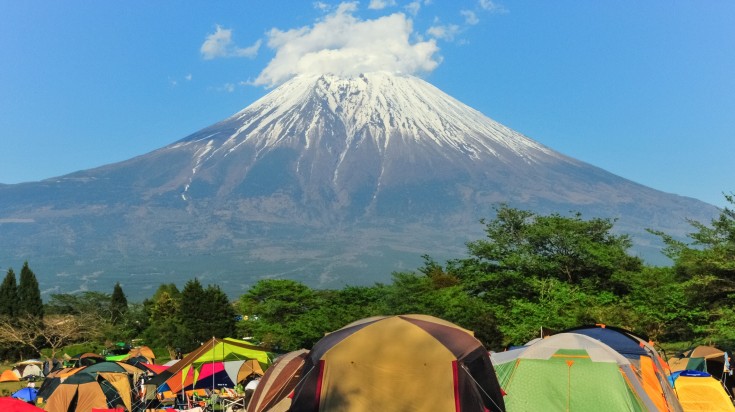Climbing Mount Fuji: The Ultimate Guide

- Saadet A
- From
- Saadet A
- From
- Jeremy T
- From
- Tayla T.
- From
4 Mount Fuji trails
1. Yoshida trail

The Yoshida trail is Mount Fuji’s most popular and well-established route. With different paths for the ascent and descent, you’ll spend your entire hike being awed by the views of the landscape from Japan’s highest point. The Yoshida trail offers the most facilities and the clearest trail markers, making it easier for less experienced hikers to make it to the summit. This trail also boasts some gorgeous wildflowers and a charming shrine you can pay a visit to along the way.
- Distance/ duration: 13 km round trip if you begin as most climbers do, at the 5th station. The ascent takes between five to seven hours and the descent takes between three to five hours.
- Difficulty level: Moderate. While this hike has easy access to amenities, shops, and medical attention, it will still require you to navigate steep rocky sections in the ascent and difficult gravelly slopes on the way down.
2. Gotemba trail

Of all Mount Fuji trails, the Gotemba trail offers you the least crowded trek up the mountain, though there is a reason for this. The Gotemba trail takes the longest route with the highest elevation change and is very sparse in amenities along the way. In exchange for the long walk, you’ll get to see the volcanic sands change from black to red and snag a great view of Lake Yamanaka! One of the highlights of this trail is the sunabashiri, or the great sand run, when the descending path separates and sends you running down the volcanic sand slope.
- Distance/ duration: 19.5 km round trip. The ascent takes between seven to ten hours including 2,350 meters of climb and the descent takes between three to five hours.
- Difficulty level: Moderate. While the trail itself is not absurdly challenging, it’s a long hike with few amenities along the way.
3. Fujinomiya trail
If you want a Mount Fuji hike that’s hard and fast, the Fujinomiya trail is the shortest ascent. It starts the furthest up the mountain and is only 3.6 kilometers to the summit, but it will challenge you all the way, from the steep ascent to the sunabashiri on the way down. This trail is shared between climbers ascending and descending, making it harder to take a wrong turn, but you’ll also need to watch out for hikers going the opposite direction. If you’re coming from western Japan, the Fujinomiya trail is the most accessible trail to get to.
- Distance/ duration: 7.6 km round trip. You will need approximately five hours for the ascent and three for the descent.
- Difficulty level: Moderate. This trail is generally quite steep and rocky, but rental equipment is available and facilities are easily accessible.
4. Subashiri trail

The Subashiri trail offers hikers some of the best views on the mountain! If you’re dreaming of climbing Mount Fuji at sunrise, this whole trail faces eastward, so you’ll get some incredible views along the way. Enjoy shaded forest walking for the first half of the hike before you emerge from the woods to take in some incredible views. This trail merges with the Yoshida trail for the last push to the summit, so it can get a bit crowded, but on your way down you can run down the volcanic sand!
- Distance/ duration: 11.7 km round trip. The ascent takes approximately five to seven hours and the descent typically takes between three to five hours.
- Difficulty level: Moderate. The ascent combines with the Yoshida trail, which gets a little tricky and pretty crowded. Also, the sunabashiri can be tough on the joints. Make sure to bring a headlamp if you’re climbing in the later hours as visibility in the forest can be quite limited.
Best time to hike Mount Fuji
Mount Fuji’s official climbing season is from mid-July to mid-September, but it’s busiest when summer holidays are underway. That coincides with the best, and most stable, weather conditions. Head to the mountain in late July or early August for the best chance at clear skies and warm temperatures — just be sure to bring sunscreen and plenty of water!
Top 5 Attractions around Mount Fuji

1. Fuji Five Lakes. Fuji Five Lakes is the region at the base of Mount Fuji, a stunning lake resort area with tons of activities for the intrepid tourist and staggeringly beautiful views of the mountain. There are five lakes here: Kawaguchiko, Saiko, Yamanakako, Shojiko and Motosuko. Of the five lakes, Kawaguchiko is the most accessible and has the most to offer. You can visit Fuji Q Highland to ride on some record-breaking roller coasters or spend your time in nature with plenty of opportunities to hike, camp, and play in the snow!
2. Oshino Hakkai springs. The springs of Oshino Hakkai, a gorgeous little village in Fuji Five Lakes, are filled with sacred water that begins when the snow melts on Mount Fuji and spends 80 years filtering down through the lava before it arrives in Oshino Hakkai. As a result, the water is so clear that it’s transparent, giving you clear views of the vibrant world underneath. Set this against a backdrop of charming thatched village homes and the towering Mount Fuji and you can see why this is such a popular place to visit!


3. Narusawa Ice Cave and Fugaku Wind Cave. Located on the northern foot of Mount Fuji only five minutes away from one another, these two famous landmarks are a must-see. Icicles hang from the ceilings of either cave year-round and the ice cave features a massive ice pond that never melts. The wind cave is home to unique lava shelves and a mystical glowing blue moss. Enter a different world beneath the mountain with a trip to the Narusawa ice cave and Fugaku wind cave. If you’re worried about accessibility, the wind cave has a walkway designed to be passable for children and the elderly.
4. Kawaguchi-ko forest. Try something a little different with a visit to the Kawaguchi-ko Music Forest Museum at the base of Mount Fuji. This village is designed in the style of the European middle age and features an expansive rose garden that fills the area with the scent of roses when it’s in bloom. You’ll find all kinds of musical instruments and historical music boxes around here, with ongoing concerts from automated instruments, talented musicians, and various mixed medium artists as well.

5. Aokigahara forest. Growing on a bed of solid hardened lava, the dense Aokigahara forest in the northwestern flank of Mount Fuji absorbs sounds, making it a place of solitude and silence where you can easily get lost if you wander from the trail. Does the name sound familiar? You may have heard this forest called by its other name, “the suicide forest.” If you like to visit the spooky and supernatural on your travels, some say that the ghosts of those who have died in this forest remain there to haunt it.
Day trips to Mount Fuji
If you’re not big on hiking but still want to include Japan’s most famous mountain on your trip to Japan, consider going on a Mount Fuji day trip! Visit Fuji Five Lakes at the mountain’s base to enjoy the gorgeous view of Fuji from the water, visit the iconic Hakone shrine by boat, or soak in the famous Fujinomiya onsen. There are activities for all interests; adrenalin junkies can ride on some of the terrifying roller coasters of Fuji Q Highland while music enthusiasts listen to the Orchestrion play at the Kawaguchi-ko Forest. You don’t have to climb to the top of Mount Fuji to enjoy its beauty in the background as you explore your interests
Good to know
- Since the trails can get foggy quickly and some of them intersect, hire a guide to ensure you stay on track all the way. Plus, opting for a Mount Fuji hike tour can open up a whole world of information about the cultural and geological significance of the mountain.
- If your route includes running down a sunabashiri, make sure to rent some gaiters and goggles or you may find the fine volcanic sand in your shoes and eyes which is a real buzzkill.
- While you may want to visit Japan during the Obon festival, plan on climbing Mount Fuji before or after. During Obon week Fuji sees a huge increase in visitors and it causes massive congestion on the trails that can have you waiting in lines on the mountainside.
- Plan to spend the night in one of Fuji’s many mountain huts. While you may be able to do the whole hike in one grueling day, you’re more likely to get altitude sickness if you do. The huts are conveniently located to give you a spot to rest before the final push so you can be at the summit by sunrise!
- Check out our packing checklist to make sure you have everything you need on climbing Mount Fuji safely!

Whether you’re an experienced hiker or a novice, there’s a Mount Fuji hike to take you to the mountaintop! With gorgeous views and the special camaraderie that forms between climbers, your trip up the mountain will be nothing short of memorable. Even if you don’t like to hike, the area surrounding this iconic mountain offers plenty of hot springs to relax in while you sneak peeks at Fuji’s silhouette above you.




